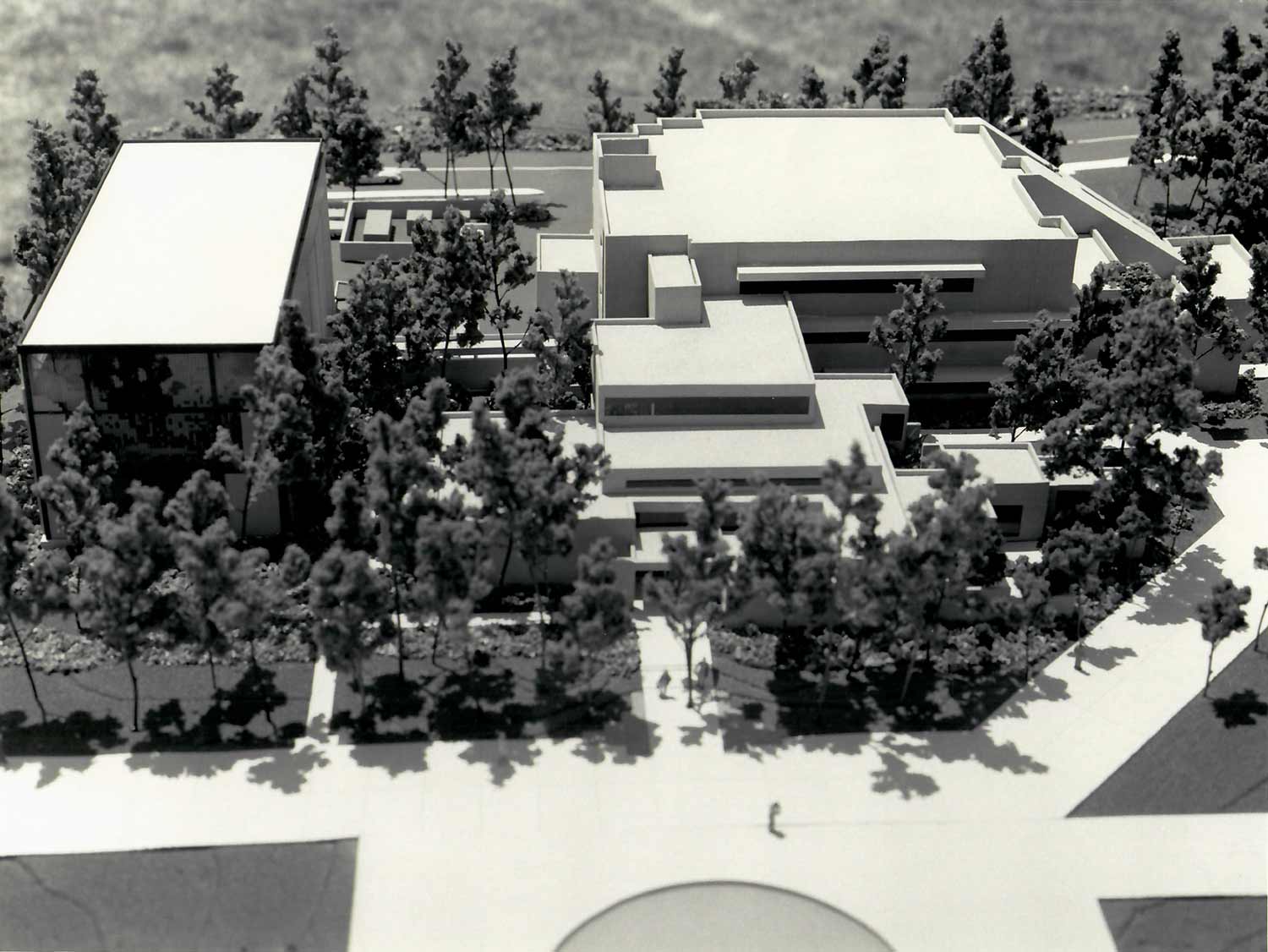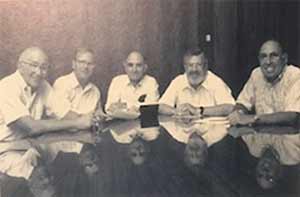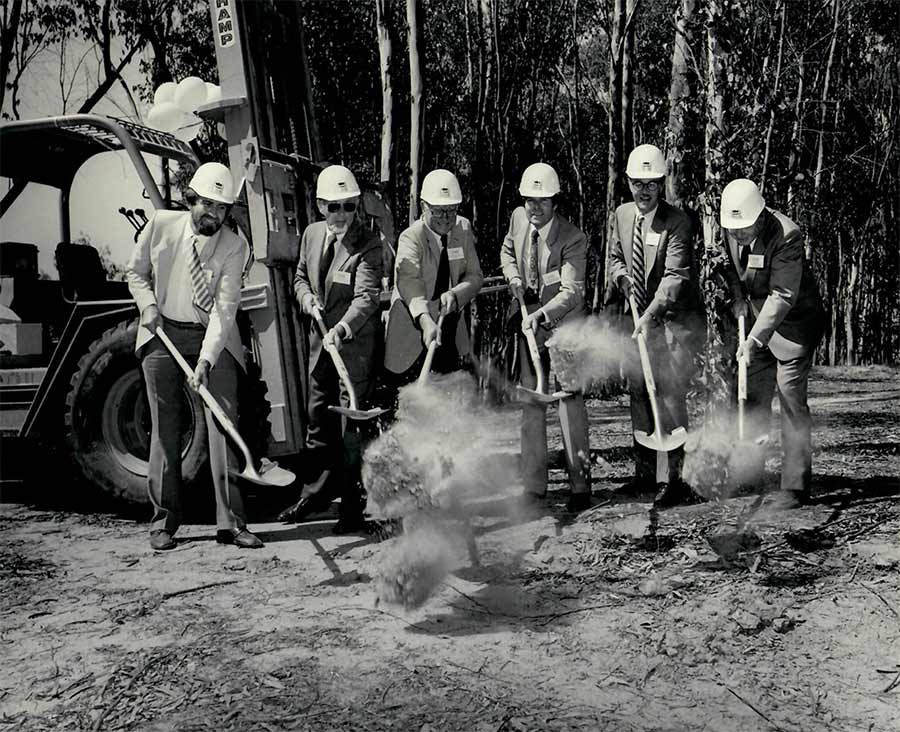By:
- Katherine Connor
Published Date
By:
- Katherine Connor
Share This:

A model of the planned Center for Memory and Recording Research building at UC San Diego.
Center for Memory and Recording Research Makes Big Contribution to Data Storage Advances Over Past 35 Years
In 1983, the state-of-the-art in data storage was a 1 gigabyte hard drive that cost $100,000 and weighed 50 pounds. Today, there are 10 terabytes of storage on a single drive at a cost of 3 cents per gigabyte.
The UC San Diego Center for Memory and Recording Research (CMRR), which is celebrating its 35th year of groundbreaking research, is responsible for many of the technological developments that enabled this transformation.
“I can’t think of another area of research that scientists and engineers are involved in that has a more profound effect on our routine way of living,” said George Tynan, professor of mechanical and aerospace engineering and Associate Dean of the Jacobs School of Engineering. “The device I carry in my pocket—and all of you have one— contains all the photographs I’ve taken since my daughter was an infant. It contains all the music I love… it contains every email correspondence I’ve had for the last decade, and allows me to communicate with anyone I need to anywhere in the world. All in a device that weighs 8 ounces and is incredibly robust even when I drop it. And that is made possible in part because of the work that goes on here.”
The CMRR opened its doors as the Center for Magnetic Recording Research in 1983 with a goal of collaborating with industry partners to further our understanding of data storage, and move the needle on what was possible. The M in CMRR changed from Magnetic to Memory Research three years ago to reflect the broadening scope of data storage away from solely magnetic recording to include solid state storage and new approaches to non-volatile memories.
A multidisciplinary approach was the backbone of the Center from the outset.
“The original mission was to advance the science and technology of information storage through multidisciplinary research, programs and partnerships with industry and government partners,” said Eric Fullerton, professor of electrical and computer engineering and director of the CMRR, who was recently inducted into the National Academy of Engineering. “The center was built almost exclusively with funds from industry.”

The four founding endowed professors of the CMRR with Sheldon Schultz. L-R: Ami Berkowitz, Frank Talke, Sheldon Schultz, NeAl Bertram and Jack Keil Wolf.
CMRR launched with four endowed professors—Jack Keil Wolf, Ami Berkowitz, Frank Talke and NeAl Bertram—under the leadership of the first center director, John Mallinson, and then Sheldon Schultz, a founding professor of the Physics Department at UC San Diego. All of the founding faculty were responsible for integral contributions to information storage, a legacy that continues with faculty today.
Shultz, for his part, received wide acclaim while at CMRR for his co-discovery of metamaterials, which allow electromagnetic waves such as light to be bent and manipulated in ways not normally encountered in nature. He was also renowned for performing the first experimental demonstration of a negative index of refraction, which can allow materials to have a unique response to electromagnetic waves.
The use of antiferromagnetism, the phenomenon in which magnetic ions are aligned in an opposing nature, as opposed to parallel ferromagnetism, was a concept championed by Berkowitz as far back as the 1960s and was used in the first IBM giant magnetoresistive read head based largely on the work in Berkowitz’s group. Fullerton carried on the torch, inventing a magnetic media called antiferromagnetically-coupled media in the 1990s, which allowed hard disk drives to store 100 billion bits of data per square inch.
“From when the center was founded to today, the amount of data you can store per inch has gone up about 1 million times,” said Fullerton, who played a large role in enabling this enormous growth. “You can store 1 million times more data per inch than when this building was built.”
Wolf advanced the field of signal processing, and brought the technique of maximum likelihood detection to data storage. This allows hard drives to read ones and zeros faster and more accurately, and is used in almost every hard drive, tape drive or DVD player made in the last two decades.
“Between NeAl and Jack and Ami and I, we had a very interdisciplinary situation where all different disciplines would get together and talk and help make progress,” said Talke, head of CMRR’s Tribology and Mechanics Lab.
That multidisciplinary approach can be seen at the center today, where a full battery production lab is down the hall from a quantum materials lab in the same building as a nanotechnology atomic force microscope.

The groundbreaking ceremony for the CMRR. Pictured: Frieder Seible, professor of Aeronautical and Mechanical Engineering Sciences (AMES) at UC San Diego; Al Blaylock, president of Blaylock- Willis and Assoc.; William D. McElroy, trustee of the Charles Lee Powell Foundation; Gil Hegemier, professor of Aeronautical and Mechanical Engineering Sciences at UC San Diego; M. Lea Rudee, dean of the engineering division; and San Diego Superior Court Judge James L. Focht
“We work with people who aren’t just from one discipline,” said Robert Tolley, a CMRR graduate student who earned a Ph.D. in electrical and computer engineering and now works at Intel. “We’ve got people who are more on the tribology side of hardware recording, or in coding, magnetism, materials. Because it’s an engineering-focused application, you have people who do everything and when you put those people in the same room together you get something really special.”
There have certainly been many really special technical advancements over the past three and half decades, but Fullerton said that is not what the center is most proud of.
“What we’ve really accomplished is our students—that’s what we’re most proud of,” Fullerton said. “Over 200 Ph.D. students have come out of this center, and many of them are leaders in industry and many go on to faculty positions.”
Erik Shipton is one of those alumni, who now works for Facebook’s Oculus virtual reality platform after a stint in academia.
“I did my Ph.D. here in experimental magnet research and now I work as a computational optical scientist—I do nanophotonics, computational research, things like that,” Shipton said. “As students, there’s so many skills you pick up here at CMRR that will let you be versatile in your career. A lot of people get stuck in a very narrow skill set and can’t jump to something more interesting, but we can.”
The next 35
While Fullerton said it’s unlikely that data density will continue to increase at the same rate it has been—a 10^5 increase over the last 35 years—there are other aspects of data storage that he predicts will experience such significant growth. One of those areas is energy efficiency.
Storing and transporting data, it turns out, takes a whole lot of energy. So much so, that in 2015 Google used the same amount of electricity to move computer bits around as the entire City of San Francisco used in a year. As the amount of data in existence increases, it’s expected—if current trends continue— that transistors will require more energy than the entire world can produce by 2038.
To prevent that, CMRR researchers are investigating ultra-low power storage, massively parallel structures and novel battery concepts.
“Battery materials are very good at storing energy—but we’re working to see if battery materials can store information,” Fullerton said. “We want to go beyond traditional electronics and are looking at different technologies—electric field gated domain walls or resistant ram where you move ions by electric field. We are also exploring magnetic switching with optical light—we’re looking at what kind of things we can do to allow us to store data much faster.”
Share This:
You May Also Like
Stay in the Know
Keep up with all the latest from UC San Diego. Subscribe to the newsletter today.



